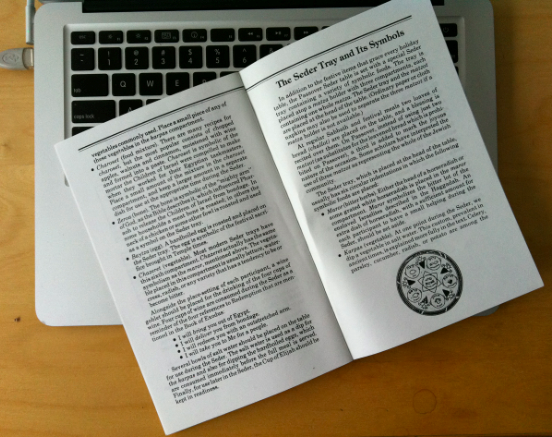
For the past few years I have used a different Passover Haggadah each time I led the family seder. Of course it is easy to find a new Hagaddah since there are a tremendous number of different versions available from a wide variety of publishers. And each brings its own perspective. For example, there are haggadot that are more gender inclusive, there is a haggadah that is intended for vegetarians (the Hagaddah of the Liberated Lamb), and there is even a haggadah for those who are seeking spiritual enlightenment. Each begins with the traditional biblical text, but then interprets it in its own unique way.
At some point during the meal in past years, my family would begin their “review”of that year’s choice in Haggadah. Now there are two directions this conversation (read “critique session”) would usually go; either along the lines of “I didn’t really like this year’s Haggadah” or more likely something like “I really hated this year’s Haggadah.” “Like” or “love” are not words generally heard when referring to any year’s Haggadah.
Two years ago when we sat down for the meal, my family asked which Haggadah we were going to use. I replied, “We need to go into the den for that.” When we got into the den, the Seder plate (which is part of the ritual) was already there. “Okay so where’s the Haggadah?” someone asked. Without a word I turned on the large flat-panel TV and started the seder.
Yes, that year our Passover Haggadah came in the form of a Keynote presentation that I had put together. It included the prayers for service, along with a series of different images. I had also decided that if I was going to do something as “out there” as this, then I might as well make it fun and truly memorable. With that goal in mind, I included a few videos I had grabbed from YouTube, and I used a lot of family photographs. My golden retriever, Maisy, was still alive at the time, and she made a cameo appearance. I included a series of comments about various family members on certain pages, and of course, I used a few clips from the movie the 10 Commandments. It was silly, it was fun, it kept people engaged, and when I did not use it last year at Passover, my family almost rebelled.
Yes, I finally found a Haggadah they liked.

This year we will be using yet another new Haggadah, and thanks to Behrman House Publishers it is going to be a collaborative effort with other members of the family. Thanks to a nifty piece of web-based technology, you can now take Behrman House’s Family Haggadah and add your own images and text. The result is a truly personalized Haggadah. Even better, the system allows you to give access to others; you can choose whether to give them Read-Only permission or full editorial rights. I’m making one, and I will give my niece Talia and nephew Joey access so they can work on it with me from their home in the Boston area.
Here’s a quick walk-through of the first steps.
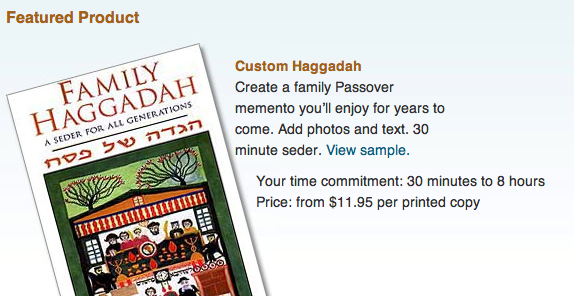
As the Web site explains, you can add a lot of text and personal pictures and spend a significant amount of time on it … or you can do just a few changes and have the process done in half an hour. You can then order printed copies of your very own, personalized Haggadah.

There are two versions available: the Standard Version gives you 34 pages with 50 images you can change, and it has 15 text areas that can be personalized. The Premium Version is a dollar more; it adds two more pages and the words and music to one of the best-loved Passover songs.
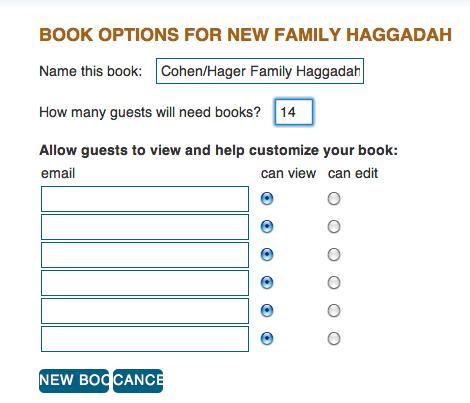
The customization starts right off the bat when you give your Haggadah a unique title.
As noted, you can also add people to work on it with you. If you only want to be able to show someone the pages you have personalized, you give them “View Only” access. This is good if, hypothetically speaking, you wanted to make sure your wife Elana is okay with the picture of her that you used in it. You can also give editorial access to others. When you do, they get an email invitation and can get to work right away.
You can also indicate how many books you expect to order.
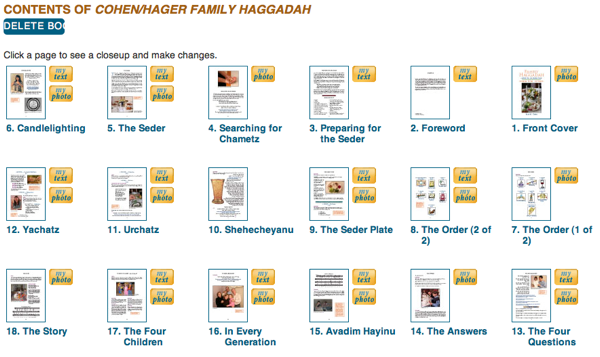
The next page shows you the full layout of the Haggadah and the places where you can customize it. “My Text” indicates an opportunity to change or add text, while “My Picture” lets you add, crop and rotate images that are on your computer.
I should note that, as of this post, the system does not render properly if you are using Safari as your browser. However, it works just fine with Chrome.
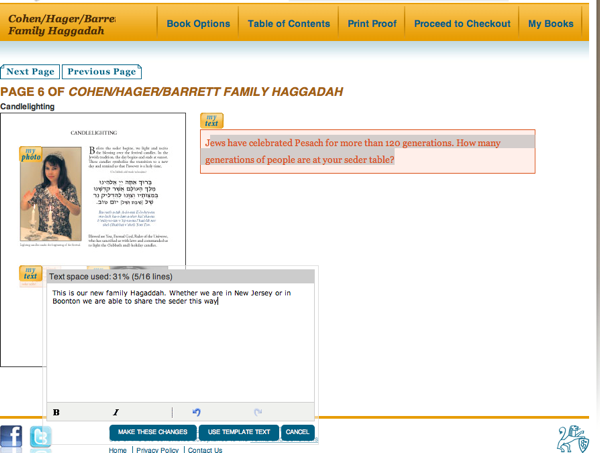
To edit a text box, you simply click “My Text”. A window opens that offers a text area as well as the ability to do some minor text formatting.
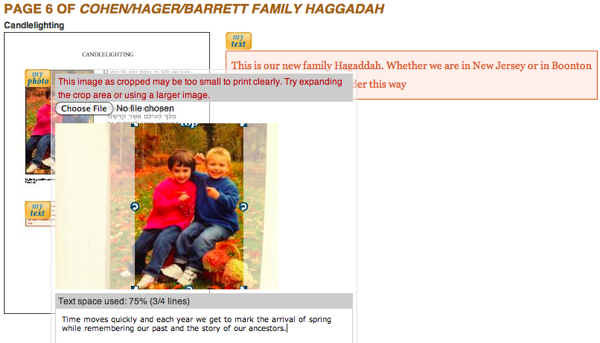
To edit an image, you click “My Photo” and then upload a picture from your desktop. Once the image is in the browser you can rotate or crop it. I found the rotation feature a bit cumbersome to use, but it does work. You can also add, change or delete the text below the image.
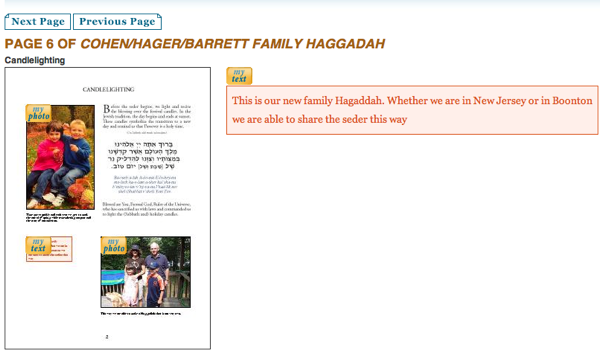
So on the first page of the Haggadah, I was able to add an old picture of my niece and nephew at the top and change the title; I added personal text in the lower left corner, and I added a picture of my sister with her family on the lower right. Once I was happy with it, I was ready to either save it and close down, or move to the next page and begin editing.
What is great about the process is that you can always go back and rework a page. Nothing is written in stone until you purchase your haggadahs and check out.
It was quite a bit of fun to get started with creating this year’s haggadah, but I stopped after the first page. Why? Because I want this to be something I do with Joey and Talia. They are away this week, but we can get to work on it upon their return. Fortunately we have time.
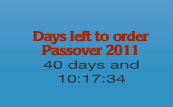
The handy countdown timer on the ‘Build Your Own Haggadah’ homepage tells me that I still have 40 days left to finish and order it. Hmmm, there’s something rather biblical about that number, no?
I can see this being a lot of fun for us, and best of all when Passover arrives we’ll get to use a Haggadah that we all created together. We’ll see how the “Haggadah of the Year Tear Down Session” goes this time around. 


